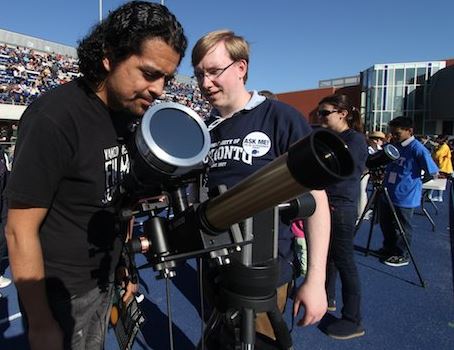Queen’s leads search for 'Super-Earth' 
01 December 2014
An astronomer in the Astrophysics Research Centre (ARC) at Queen’s has led an international team to detect a super-Earth, a planet with more mass than Earth but less than Uranus or Neptune, using a telescope on the ground. The research could pave the way in the search for life on other planets.
Up to now, only space-based telescopes have been able to detect planets near the size of the Earth that pass in front of stars like the Sun.
Previously, this has only been possible for one other super-Earth circling a star much fainter and cooler than the Sun. This breakthrough opens up new ways to study other worlds.
The planet, called 55 Cancri e, periodically passes in front of a star only 40 light years from the Earth. The star can be seen with the naked eye on a clear and moonless night. For this detection the team used the 2.5-meter Nordic Optical Telescope; previous observations of this planet had to rely on telescopes in space.
According to Dr Ernst de Mooij (right, above), the Michael West Fellow at the School of Mathematics and Physics at Queen’s, who was the lead author of the study, the planet 55 Cancri e is far from hospitable for life, at twice the diameter of Earth and temperatures reaching nearly 1700 Celsius.
Their study paves the way for studying many more planets similar in size to Earth with telescopes on the ground. Some of these planets may even have the conditions needed to sustain life.
Dr de Mooij said: “This is especially important because upcoming space missions such as the NASA TESS mission in 2017 and ESA’s (European Space Agency) PLATO mission in 2024, which should find many small planets around bright stars which are ideally suited for this type of study.”
“Observations like these are paving the way as we strive towards searching for signs of life on alien planets from afar. Remote sensing across tens of light-years is not easy, but it can be done with the right technique and a bit of ingenuity,” added study co-author Dr Ray Jayawardhana of York University, Canada.
Dr de Mooij moved to ARC from the University of Toronto to Queen’s in October. The research team also includes Dr Mercedes Lopez-Morales of the Harvard-Smithsonian Center for Astrophysics in the USA as well as Dr Raine Karjalainen and Dr Marie Hrudkova of the Isaac Newton Group of Telescopes on La Palma, Spain. Their findings appear in a paper to be published in the Astrophysical Journal Letters.
The Michael West Research Fellowship is a 3-year fully-funded fellowship affording the holder a unique opportunity to pursue their own astronomical research programme. It is funded by Michael and Ruth West, both graduates of Queen’s, who also support the Michael West Lecture Series at the University.
With an interest in engineering, a good academic record, and the encouragement of his mother he worked towards a scholarship to Queen’s. A 1960 Civil Engineering graduate, Michael almost didn’t make it to Queen’s when there was a problem with the administration of his grant.
A former CEO of GKN – specialists in ground engineering, structural renovation and post-tension systems – Michael was awarded an honorary DSc in Engineering by Queen’s in 1997.
Speaking when the Research Fellowship was established, Michael said: “We owe a lot to Queen’s. Our education was crucial to the decisions we made throughout life. The cliff-hanger feeling of financial insecurity I experienced, wondering whether or not I could take up my place at Queen’s in 1955, always niggled and perhaps made me slightly more driven. To me it is blindingly obvious that I should put something back.”
Astrophysics is one of the main themes of the University’s ‘Beyond’ fundraising campaign.
Photo (above): Ernst de Mooij (right) demonstrates his H-alpha telescope
Headline image: An artist’s impression of exoplanet 55 Cancri e compared to the size of the Earth. Its parent star, 55 Cancri, is about 40 light-years away and just visible to the naked eye. Image credit: York University, Toronto, ON, Canada
For media inquiries please contact Andrew Kennedy, Queen’s University Communications Office, on 028 9097 5384 or email andrew.kennedy@qub.ac.uk
Back to Main News
Top of Page